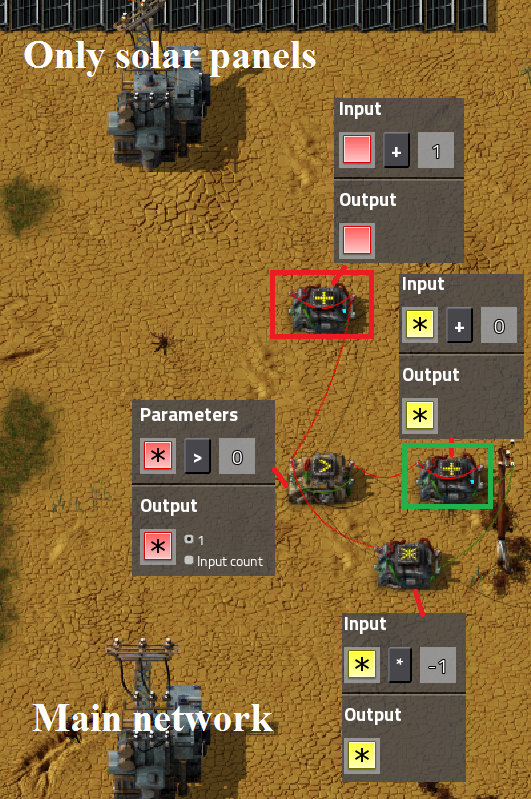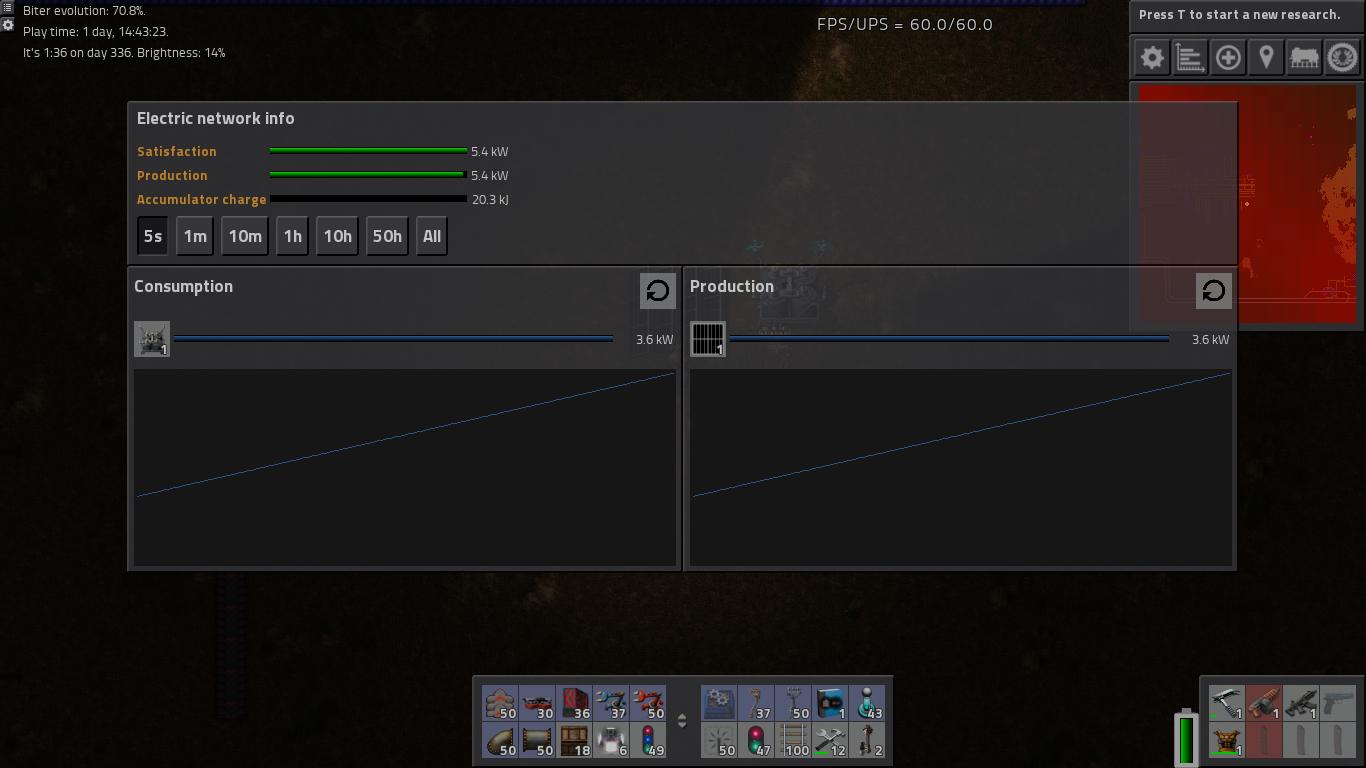The perfect acc./solarpanel ratio. Wiki seems wrong
Posted: Sun Jul 03, 2016 12:44 pm
I'm going to be rather pedantic about this to avoid useless discussions caused by miscommunication. Sry for the wall of text.
I was doing some research about this and I found this thread: http://forums.factorio.com/viewtopic.php?f=5&t=5594.
In it the OP calculates the perfect ratio of accumulator/solar panel ratio to be 0.84 accumulators for every panel.
I believe that his method was correct (after some help of others) but the numbers he used as input are now very old (accurate as of 0.11.8 according to the wiki). So I wondered if they have changed since then.
To be clear, he used the following information from the wiki (https://wiki.factorio.com/index.php?title=Game-day):
1 game day = 25000 ticks
day-phase = 12500 ticks (or 50% of a game day)
dusk and dawn phase are equal and are 5000 ticks each (or 20% of game day)
night phase = 2500 ticks (or 10% of a game day)
So I took a good look at that wiki page and found that the numbers in the table are not consistent with each other. The table specifies the duration of each phase both in ticks and in seconds and they match up. But it also specifies at what point during a game day each phase starts and ends and those numbers say something different.
For example, dusk would start at 25% of a day and end at 42% of a day. That implies that dusk would be 42-25 = 17% of a game day. But 17% of 25000 ticks is 4250 ticks and not 5000 ticks. The same goes for night and dawn. So this wiki page is at least partially incorrect.
Then I decided to measure some things by my self. I used the mod EvoGui for this. It shows the current time of the day and the current brightness level (using LuaSurface.darkness). I noted down at what times the brightness changes and I measured the duration of a complete day using a stop watch. The duration of a day was always 7 minutes and a couple of seconds, including the intermittent autosaves and the occasional lagspike (doing this on my lappy). This confirms that a game day actually does last for 25000 ticks.
This is what I noted down for the individual phases:
dawn starts at 02:00 and ends at 06:00, lasting for 4 game-day hours total.
The day-phase starts at 06:00 and ends at 18:00, lasting for 12 hours.
Dusk starts at 18:00 and ends at 22:00, giving 4 hours.
Night then starts at 22:00 and ends at 02:00 for 4 hours.
This completely contradicts the right hand side of that table (tick duration and second duration) on the wiki while confirming the left hand side of the table (duration as a percentage of a day). This also means that the input used in the ratio calculation is wrong. This is what you get when using the new inputs:
(copied from the original thread and modified)
=============================================
n / m = (E_acc / P') * (o / c) = [(t1 + t3) * [t2 + t3 * (t1 + t3) / T] / T] * (o/c)
o = 60 kW
c = 5000 kJ
t1 = 0.5 (as before)
t2 = 1/6 (=0.16666667)
t3 = 1/6 (=0.16666667) (which is counted twice, visible in the graph in the first post)
T = 1.0
Times are in fraction of day, so they must be multiplied by (25 000 / 60). With these numbers, the numerical application gives us :
n / m = [(0.5 + 1/6) * [1/6 + 1/6*((0.5+1/6) / 1.0] / 1.0] * (25 000 / 60) * (60 / 5000) = 0.92592593
=============================================
Where n is the number of accumulators you need, m is the number of solar panels you need, E_acc is the energy stored in all needed accumulators when fully charged, P' is the power output of all solar panels (being power requirements of base + power requirements to charge all accumulators during the day+dusk+dawn), o is the output of a singel panel at 100% brightness, c is the capacity of an accumulator, t1 is the duration of the day-phase as a percentage of a whole game-day, t2 is the duration of the night phase and t3 is the duration of both dusk and dawn. T is just the duration of a complete day.
The derivation of the equation can be found in the linked thread.
Conclusion: the ratio is different from 0.84 and thus any solarpanel field designs need to be adjusted to this.
I hope that everything is clear and if I have made any mistakes I would love to know.
I was doing some research about this and I found this thread: http://forums.factorio.com/viewtopic.php?f=5&t=5594.
In it the OP calculates the perfect ratio of accumulator/solar panel ratio to be 0.84 accumulators for every panel.
I believe that his method was correct (after some help of others) but the numbers he used as input are now very old (accurate as of 0.11.8 according to the wiki). So I wondered if they have changed since then.
To be clear, he used the following information from the wiki (https://wiki.factorio.com/index.php?title=Game-day):
1 game day = 25000 ticks
day-phase = 12500 ticks (or 50% of a game day)
dusk and dawn phase are equal and are 5000 ticks each (or 20% of game day)
night phase = 2500 ticks (or 10% of a game day)
So I took a good look at that wiki page and found that the numbers in the table are not consistent with each other. The table specifies the duration of each phase both in ticks and in seconds and they match up. But it also specifies at what point during a game day each phase starts and ends and those numbers say something different.
For example, dusk would start at 25% of a day and end at 42% of a day. That implies that dusk would be 42-25 = 17% of a game day. But 17% of 25000 ticks is 4250 ticks and not 5000 ticks. The same goes for night and dawn. So this wiki page is at least partially incorrect.
Then I decided to measure some things by my self. I used the mod EvoGui for this. It shows the current time of the day and the current brightness level (using LuaSurface.darkness). I noted down at what times the brightness changes and I measured the duration of a complete day using a stop watch. The duration of a day was always 7 minutes and a couple of seconds, including the intermittent autosaves and the occasional lagspike (doing this on my lappy). This confirms that a game day actually does last for 25000 ticks.
This is what I noted down for the individual phases:
dawn starts at 02:00 and ends at 06:00, lasting for 4 game-day hours total.
The day-phase starts at 06:00 and ends at 18:00, lasting for 12 hours.
Dusk starts at 18:00 and ends at 22:00, giving 4 hours.
Night then starts at 22:00 and ends at 02:00 for 4 hours.
This completely contradicts the right hand side of that table (tick duration and second duration) on the wiki while confirming the left hand side of the table (duration as a percentage of a day). This also means that the input used in the ratio calculation is wrong. This is what you get when using the new inputs:
(copied from the original thread and modified)
=============================================
n / m = (E_acc / P') * (o / c) = [(t1 + t3) * [t2 + t3 * (t1 + t3) / T] / T] * (o/c)
o = 60 kW
c = 5000 kJ
t1 = 0.5 (as before)
t2 = 1/6 (=0.16666667)
t3 = 1/6 (=0.16666667) (which is counted twice, visible in the graph in the first post)
T = 1.0
Times are in fraction of day, so they must be multiplied by (25 000 / 60). With these numbers, the numerical application gives us :
n / m = [(0.5 + 1/6) * [1/6 + 1/6*((0.5+1/6) / 1.0] / 1.0] * (25 000 / 60) * (60 / 5000) = 0.92592593
=============================================
Where n is the number of accumulators you need, m is the number of solar panels you need, E_acc is the energy stored in all needed accumulators when fully charged, P' is the power output of all solar panels (being power requirements of base + power requirements to charge all accumulators during the day+dusk+dawn), o is the output of a singel panel at 100% brightness, c is the capacity of an accumulator, t1 is the duration of the day-phase as a percentage of a whole game-day, t2 is the duration of the night phase and t3 is the duration of both dusk and dawn. T is just the duration of a complete day.
The derivation of the equation can be found in the linked thread.
Conclusion: the ratio is different from 0.84 and thus any solarpanel field designs need to be adjusted to this.
I hope that everything is clear and if I have made any mistakes I would love to know.

